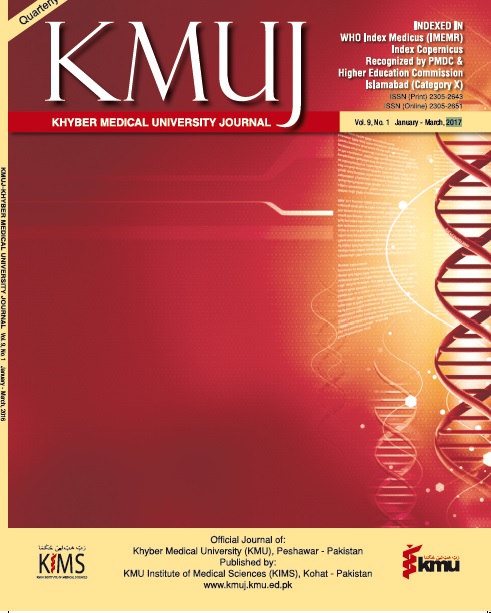RISK FACTORS IN ACUTE MYOCARDIAL INFARCTION PATIENTS ADMITTED AT THREE HEALTH CENTRES OF SINDH, PAKISTAN: A CASE CONTROL STUDY
Main Article Content
Abstract
OBJECTIVE: To determine the risk factors of acute myocardial infarction (AMI) among adults aged >40 years.
METHODS: A sample containing 100 cases and 200 controls were selected consecutively. Inclusion criteria for cases were patients with AMI, aged 40 years and above; while controls had patients with normal ECG interpretation, aged 40 years and above. Both genders (male/ females) were included as cases and controls. Patients with multiple admissions, with coma or critical condition or those who refused to participate in the study were excluded.
RESULTS: Among 300 subjects, there were 156 males (52%) and 144 females (48%). Majority of subjects (52%) belonged to 40-50 years of age group. Thirty-one percent subjects were over-weight. Majority was non-smokers and carried out exercise. Majority (67.7%) also reported normal cholesterol levels. Among them, 111 (37%) were hypertensive, 23% diabetic, while 51.66% reported stress in their previous life. Males were more likely to develop AMI versus females (OR=3.09, 95%CI=1.50-3.10). Age group 40-50 years was also highly associated with AMI (OR=5.36, 95%CI=2.70-10.72). Patients who were smokers, with positive family history of cardiac diseases, hyper-cholesterol levels, hypertension, diabetes, stress and having no physical activity were more likely to develop AMI versus their controls.
CONCLUSION: This study found that age group 40–50 years, male gender, over-weight, stress, hypertension and positive family history are the major risk factors for acute AMI in the study population and most of these risk factors are modifiable.
KEY WORDS: Acute myocardial infarction (Non-MeSH); Coronary Artery Disease (MeSH); Risk factors (MeSH); Stress (Non-MeSH), Hypertension (MeSH), Body Mass Index (MeSH)
Article Details
Work published in KMUJ is licensed under a
Creative Commons Attribution 4.0 License
Authors are permitted and encouraged to post their work online (e.g., in institutional repositories or on their website) prior to and during the submission process, as it can lead to productive exchanges, as well as earlier and greater citation of published work.
(e.g., in institutional repositories or on their website) prior to and during the submission process, as it can lead to productive exchanges, as well as earlier and greater citation of published work.
References
REFERENCES
Kesteloot H, Sans S, Kromhout D. Evo¬lution of all-causes and cardiovascular mortality in the age-group 75-84 years in Europe during the period 1970-1996; a comparison with worldwide changes. Eur Heart J 2002; 23(5):384-98.
Vasan RS, Benjamin EJ, Sullivan LM, D’agostino RB. The Burden of Increasing Worldwide Cardiovascular Diseases. Hurst’s The Heart. 11th ed. New York: Mc Graw Hill 2004:15-40.
Simoons ML; 2002 Congress European Society of Cardiology. Cardio-vascular disease in Europe: challenges for the medical profession. Opening address of the 2002 Congress European Society of Cardiology. Eur Heart J 2003; 24(1):8-12.
Levi F, Lucchini F, Negri E, La Vecchia C. Trends in mortality from cardiovascular and cerebrovascular diseases in Europe and other areas of the world. Heart 2002; 88(2):119-24.
Jafar TH, Jafary FH, Jessani S, Chaturvedi N. Heart disease epidemic in Pakistan: women and men at equal risk. Am Heart J 2005;150(2):221-6.
Anand SS, Islam S, Rosengren A, Franzosi MG, Steyn K, Yusufali AH, et al. Risk factors for myocardial infarction in women and men: insights from the INTERHEART study. Eur Heart J 2008;29(7):932-40.
Joshi P, Islam S, Pais P, Reddy S, Dorairaj P, Kazmi K, et al. Risk factors for early myocardial infarction in South Asians compared with individuals in other countries. J Am Med Assoc 2007;297(3):286-94.
Wolf R, Habel F, Heiermann M, Jäkel R, Sinn R. Cardiac risk of coronary patients after reintegration into occupations with heavy physical exertion. Z Kardiol 2005; 94(4): 265-73
Baran B, Yilmaz Y, Algin O, Keskin M, Kiyici M, Kocamaz G, et al. Acute myocardial infarction, ischemic cerebrovascular disease and variceal bleeding due to portal vein thrombosis in a patient with hereditary thrombophilia. Blood Coagul Fibrinolysis 2008;19(3):243-6.
Critchley JA, Capewell S. Mortality risk reduction associated with smoking cessation in patients with coronary heart disease: a systemic review. J Am Med Assoc 2003;290(1):86-97.
Lekhal S, Børvik T, Nordøy A, Hansen JB. Increased postprandial triglyceride- rich lipoprotein levels in elderly survivors of myocardial infarction. Lipids 2008;43(6):507-15.
Mooradian AD, Haas MJ, Wehmeier KR, Wong NC. Obesity-related changes in high-density lipoprotein metabolism. Obesity 2008;16(6):1152-60.
Yusuf S, Hawken S, Ounpuu S, Dans T, Avezum A, Lanas F, et al; INTERHEART Study Investigators. Effect of potentially modifiable risk factors associated with myocardial infarction in 52 countries (the INTERHEART study): case-control study. Lancet 2004;364(9438):937-52.
Egstrup M, Henriksen FL, Høfsten DE, Jensen BK, Hangaard J, Egstrup K. Prevalence of glucometabolic abnormalities in connection with myocardial infarction in a Danish coronary care unit. Ugeskr Laeger 2008;170(11):942-6.
Shen BJ, Avivi YE, Todaro JF, Spiro A, Laurenceau JP, Ward KD, et al. Anxiety characteristics independently and prospectively predict myocardial infarction in men the unique contribution of anxiety among psychologic factors. J Am Coll Cardiol 2008;51(2):113-9.
Abbasi A, Saleem A, Rather A, Arooj S, Habib N, Aziz W. Statistical study of the risk factors of myocardial infarction in the patients of district Muzaffarabad capital of Azad Jammu and Kashmir. Pak J Pharm Sci 2015 May 1;28(3):921-6.
Kurd BJ, Dar MI, Shoaib M, Malik L, Aijaz Z, Asif I. Relationship between stress and coronary heart disease. Asian Cardiovasc Thorac Ann 2014 Feb;22(2):142-7.
Iqbal R, Iqbal SP, Yakub M, Tareen AK, Iqbal MP. Major dietary patterns and risk of acute myocardial infarction in young, urban Pakistani population. Pak J Med Sci 2015 Sep;31(5):1213-8.
